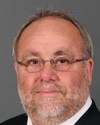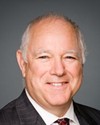I will run through this as quickly as I possibly can. I apologize that you can't see the PowerPoint. That would have been much easier, but let me go ahead.
I'm Ann Patterson. I'm the acting chief of staff here. I've been acting since the presidential inauguration, so not for very long. There very well may be some questions that you have in the end that I won't be able to answer, but I'm certainly willing to get back to you if we can establish a point of contact.
The Department of Veterans Affairs has been in operation for about 20 years. We're getting ready next weekend to have our 20th anniversary celebration.
We're divided into three administrations: Veterans Health Administration, Veterans Benefits Administration, and National Cemetery Administration. I work for Veterans Health Administration so that's what I'll focus on for the time we have.
To honour America's veterans by providing exceptional health care that improves their health and well-being is our motto. Our Under Secretary for Health is Dr. Michael Kussman, and his priorities are putting patient care first, leadership, promoting improved business practices, and producing and maintaining meaningful performance measures. Those were rolled out to our entire staff about a year ago. I think most everybody is very familiar with those priorities, and certainly he has established initiatives to make sure that we promote those.
These are some of the key facts that may be interesting to you. In 2008 we cared for 5.6 million veterans. We are among the largest providers of health professional training in the world. We train 100,000 students each year and are affiliated with 107 medical schools. We're among the largest and most productive research organizations in the United States. We're a principal federal asset for providing medical assistance in major disasters, and we're the largest direct care provider for homeless persons in the United States.
Quality is something we have really focused on over the last decade. Now I'm proud to say that we're recognized as a world leader in providing high-quality health care. We have an elaborate performance measurement system that was established back in 1996, and we believe this really has moved us and advanced us to the point where we are today.
We meet or exceed the performance of commercial health plans, Medicare or Medicaid, in each of the 18 quality measures that are pertinent to VA patient populations. We are and have been the benchmark in patient satisfaction through the American customer satisfaction index, for the past seven consecutive years.
A few years ago the RAND Corporation demonstrated that VA leads the nation for preventative health services and chronic disease management. The study found that VA patients received higher-quality care than comparable patients receiving care from other providers.
One of the latest products is a book called Best Care Anywhere, which was written by an investigative reporter named Phil Longman, who went searching for the hospital in the United States where Americans received the best health care available after his wife died of cancer. After several years of study he indicated that VA was the place where Americans got the best health care, and his recent book called Best Care Anywhere explains that.
You are all very aware of the electronic health record that we have, and I think Gail Graham, who is a colleague of mine, is going to spend some time with you in about two weeks going over the electronic health record. For now, in the interest of time, I'm not going to go into that very much.
The one thing I do want to say is that My HealtheVet, which is a fairly new functionality, allows veterans to actually dial in and get information, order prescriptions, and talk to their physicians. That is one of our most impressive functionalities now. I think Gail will go into that, as well as Vista Imaging, bar code medication administration, clinical reminders, and online prescription refills. Again, I think we filled nearly 8.8 million refills through 11/30/08.
We also have seven consolidated mail-out pharmacies. I think we were the first to establish a consolidated mail-out pharmacy. We provide 200 million 30-day equivalents per year.
As I said, we treat 5.6 million patients, or we did in fiscal year 2008. The median age of our veterans is 63. In the next 10 years there will be a 42% increase in veterans 85 years and older.
By 2018, the number of enrolled women veterans is expected to increase by 58%. I have a number of statistics about female veterans. We are really focusing on female veterans now. We have recently required every VA facility--we have 153 of them--to have its own women veterans coordinator.
One of the other things that we have focused on in the last 10 years or so is community-based and ambulatory care. Back in 1996, I think we had about 100 or maybe 200 community clinics. Now we have 919 community-based clinics. They are established, actually, through our local facilities, which determine, based on geography and a number of other things such as market penetration, where we need to have community-based outpatient clinics.
We have actually brought that process into central office recently to make sure that we are consistently applying our access standards. So now there is not only the expectation that medical centres will determine where they need CBOCs, but they have to come into headquarters for an approval through central office.
We're also focusing on rural care. We have established a new Office of Rural Health. Many initiatives are being rolled out. One is mobile clinics. Ten of them are being implemented. I don't think more than two have actually started operation, but ten of them are expected to be operational in the next year.
We have 135 community living centres. Last year we changed the name of our nursing home care units to community living centres, and there are initiatives to try to make those environments more homelike.
We have 230 vet centres. Vet centres are non-institutional. They are usually away from our main facilities. Mostly, they are a kind of peer-to-peer counselling centre. We also have 50 mobile vet centre vans that are being deployed this year.
We have 48 domiciliaries.
I've mentioned central office a number of times. We're organized regionally. We have 21 veterans integrated service networks. All of our facilities fall under one of the directors of VISN, the veterans integrated service network. The VISNs range between about three facilities in some of our small geographic areas like Washington, D.C., and New York City, where we may have a few facilities, and up to ten facilities in some of our western areas.
I mentioned our community-based outpatient clinics, CBOCs, a little while ago. Some of those are VA-staffed and some are contract care. We make sure that our contracts include all of the quality issues, the credentialling and privileging and all of those things, so that there will be no difference, really, in the type of treatment that a veteran gets should he or she choose to go to a contract clinic.
In 2009 our budget is $44.5 billion. We have three appropriations to which our money is allocated. There are medical services, medical support and compliance, and medical facilities appropriation. I have a lot of information about what goes into each appropriation, which I could certainly share with you.
Our method for allocating dollars is called VERA, which is veterans equitable resource allocation system, which was developed in 1997. It uses a modified capitation allocation methodology to distribute the money each year to the 21 networks.
We have 245,000 employees, 31% of whom are veterans. We have 18,000 physicians, about 6,000 pharmacists, 49,000 nurses, and about 900 dentists. I'm sure you all understand that we have tons of workforce challenges. Approximately 40% of VHA employees are eligible to retire by FY 2014, and more than 80% of our senior executives are eligible to retire by 2014. Clearly we are experiencing, as everyone is, the shortage of health care workers, for example, registered nurses. We have all kinds of recruitment enticements for nurses.
We are very proud of some of our research milestones. There are a lot of accomplishments that have occurred through the research of the DVA: the invention of the cardiac pacemaker, our first successful liver transplant, the first rehabilitation program for blind persons, and development of the nicotine patch.
With respect to our newest returning veterans, we continue to work on our seamless transition from the military. There are a lot of ways in which we try to reach out and touch the new veterans who are coming back. We send letters to every veteran welcoming them home. We have a very elaborate care management system that we have put into place. Every facility has an OEF/OIF point of contact and an OEF/OIF program manager.
This year our previous secretary initiated a combat veteran call centre. We went back and looked at every single person who had been separated from the military and who had not used the VA system and we called every one of them. We left messages. We had scripts that were developed to talk to them to explain to them what their benefits were, and we're now tracking to see how many of them will come to the VA to use our services.
When combat veterans come home, they are offered five years of free VA health care. We have screening programs that we've established for these new veterans. One is for PTSD and one is for TBI.
As I said, we've put points of contact in every facility. We have outreach coordinators in almost every facility. We have transition patient advocates who help transition our returning service members from Walter Reed, from the military facilities to the VA facilities.
With respect to polytrauma, I mentioned TBI and PTSD. There are a number of folks who come back and who fall into a category called polytrauma. We have established polytrauma centres in four of our big medical centres. We're getting ready to establish a fifth one in San Antonio. Every vision and every facility has at least a polytrauma support clinic.
Mental health is another huge initiative for us. We have hired 4,000 new mental health clinicians in the last couple of years. Every CBOC has to have a professional in mental health who can treat patients who go to a CBOC.
Regarding suicide prevention, back in July 2007 we established a suicide prevention hotline through health and human services. We have coordinators in every facility. The hotline is 24/7, and we believe we have saved about 2,800 lives since the hotline started.
We are tracking the common injuries and issues of our OEF/OIF population, and we actually have made sure that anyone with a severe injury has a case manager assigned to them.
I have run through most of my slides. Why don't I stop now and see if there are questions you all have?




